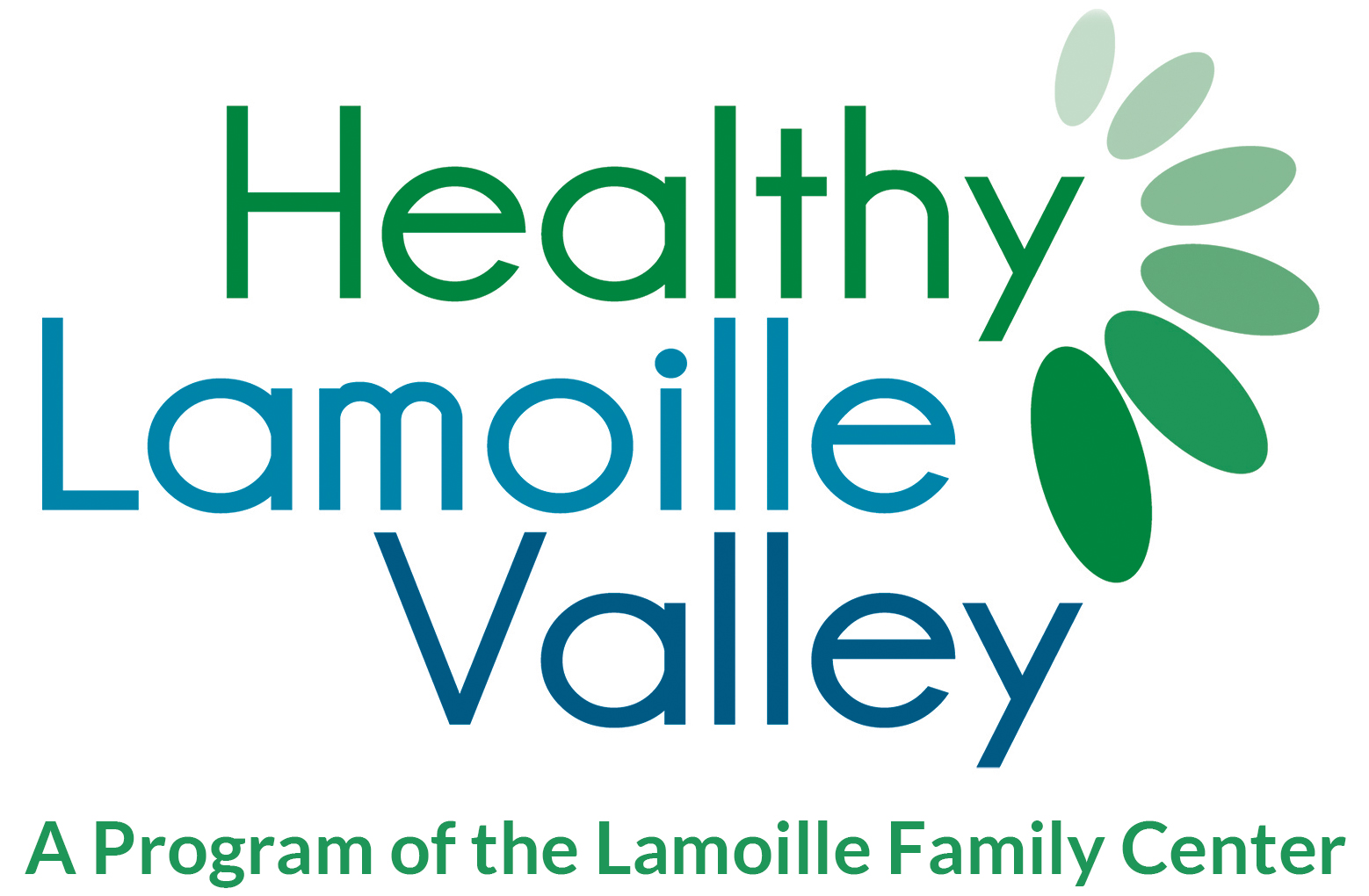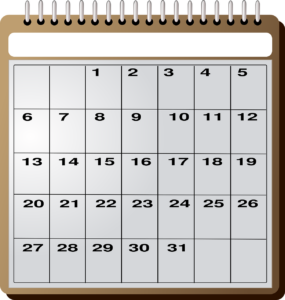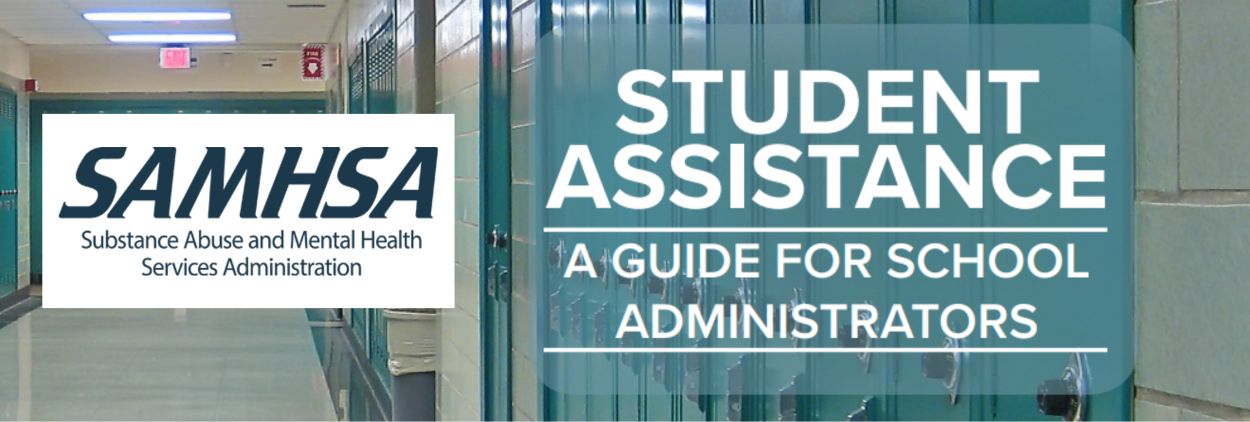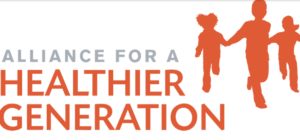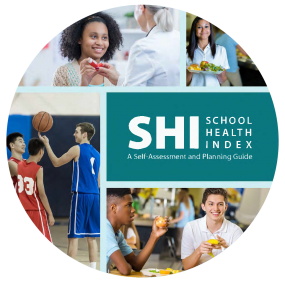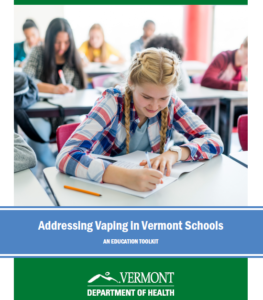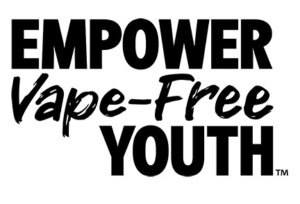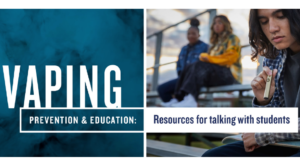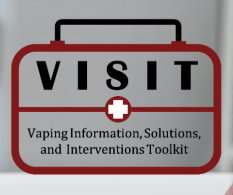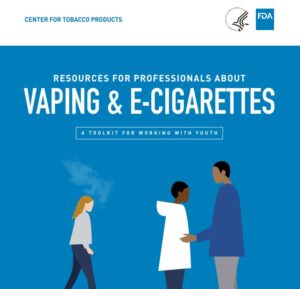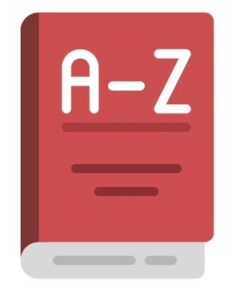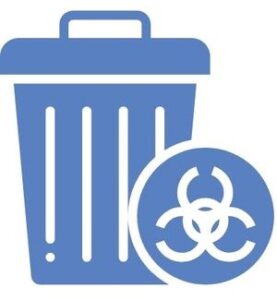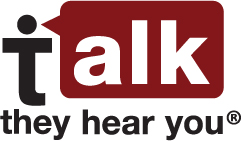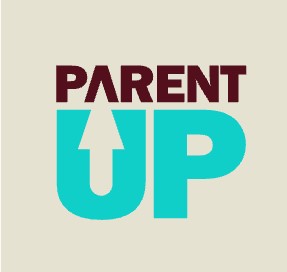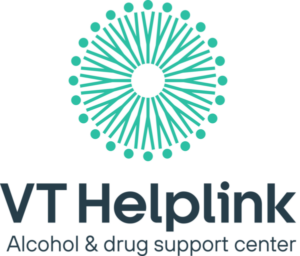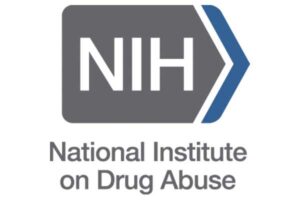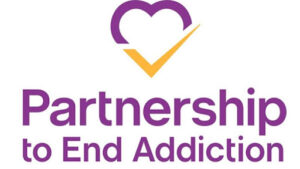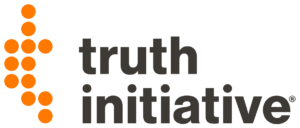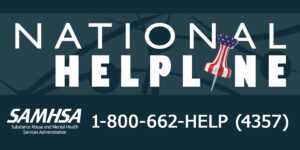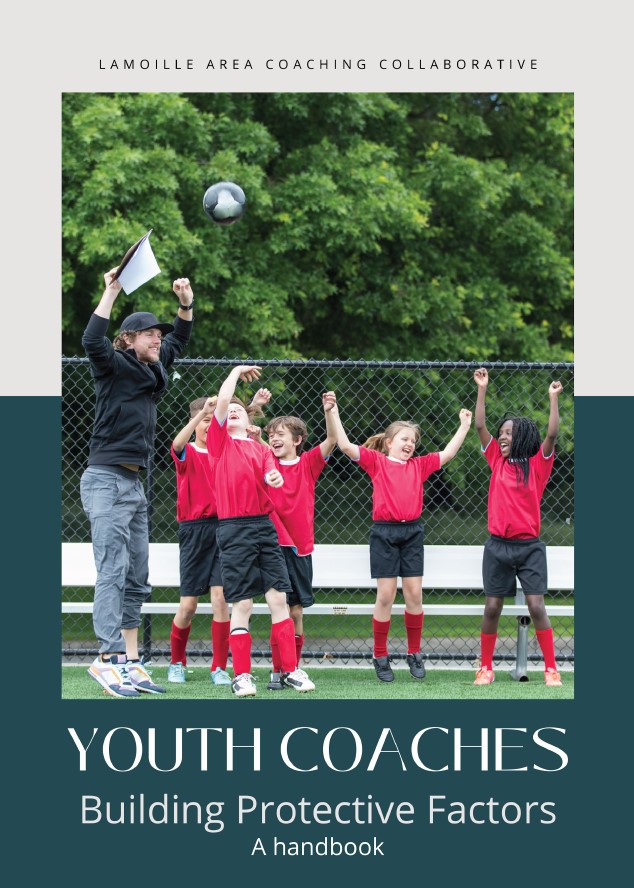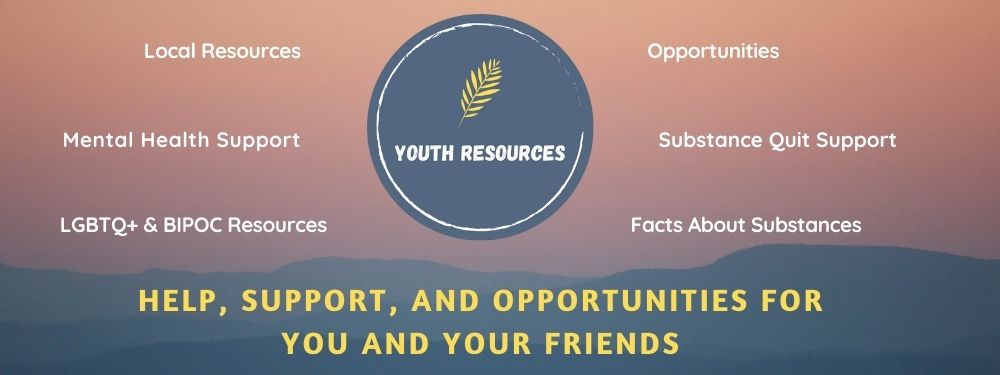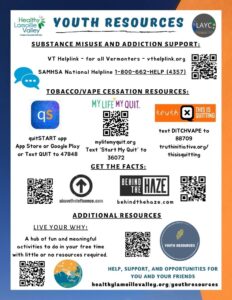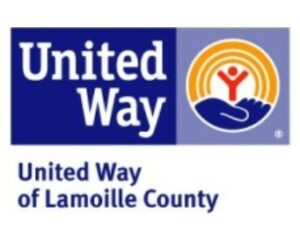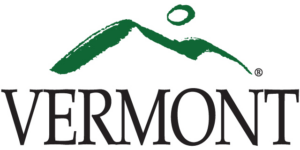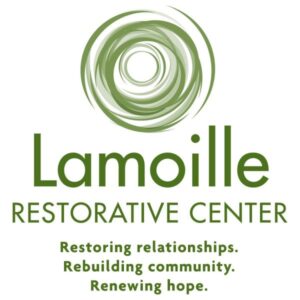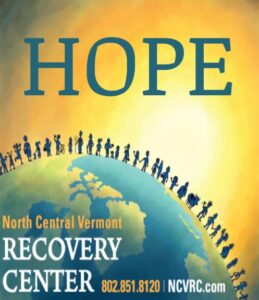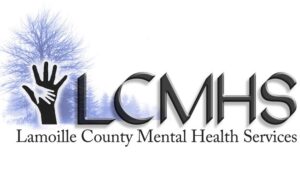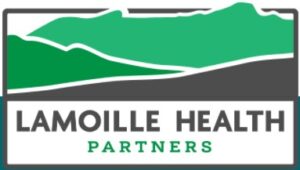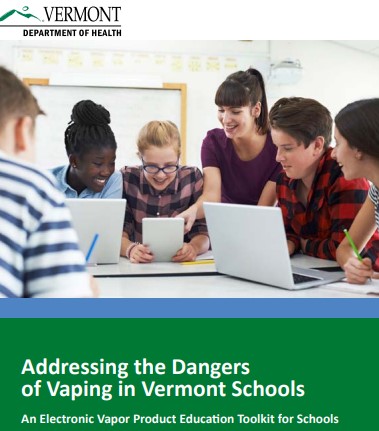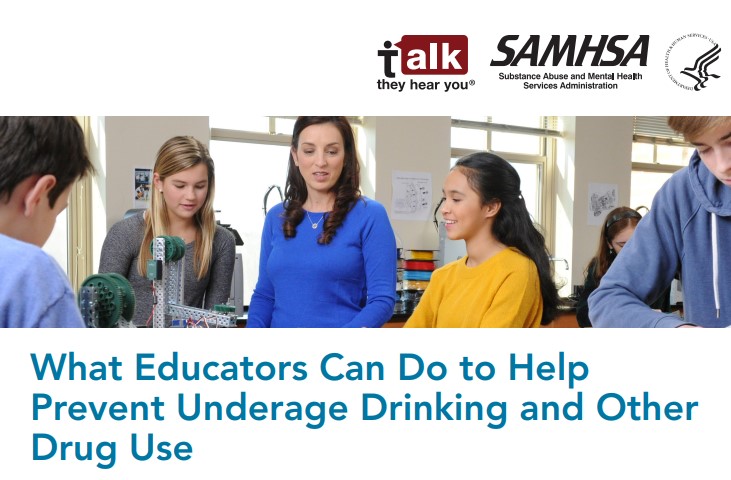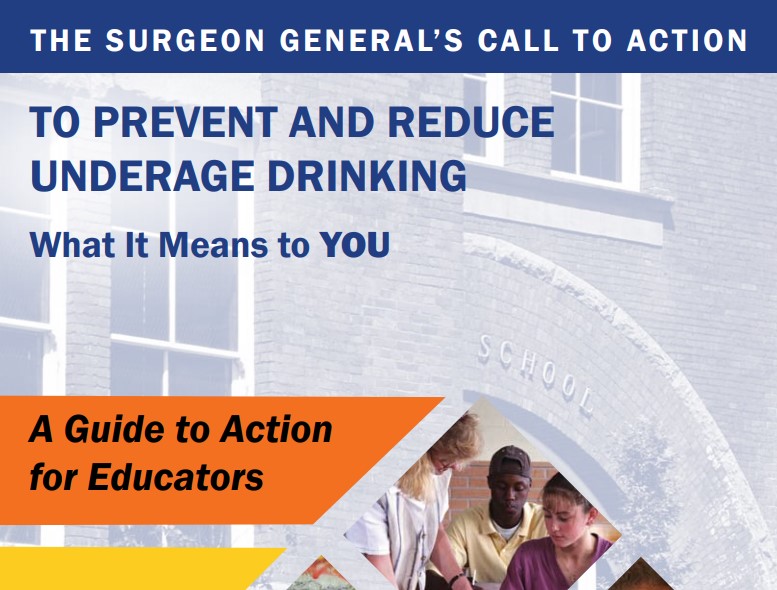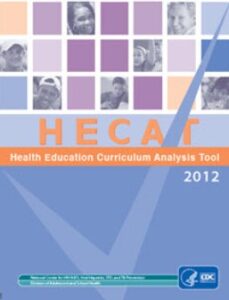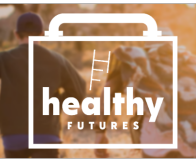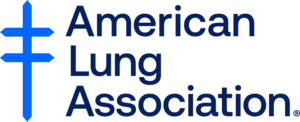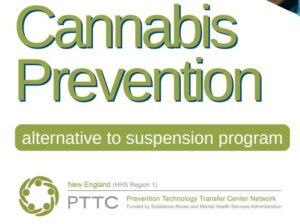Substance Prevention Resources for Schools
We’d love to collaborate! Contact Healthy Lamoille Valley Youth Substance Prevention Coordinator – carrie@healthylamoillevalley.org
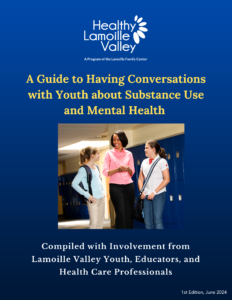 New! Conversation guide for educators!
New! Conversation guide for educators!
This guide is intended for Lamoille Valley educators and those who work with youth to provide a common language across sectors. Download the guide!
Resources For School Administrators & School Health team
This guide addresses school connectedness, substance use, mental health promotion, and violence prevention. Includes information about effective planning, implementation, evaluation, and sustainability of student assistance programs
The School Health Index (SHI) Self-Assessment and Planning Guide is an online self-evaluation and planning tool for schools. The SHI is built on CDC’s research-based guidelines for school health programs that identify the policies and practices most likely to be effective in reducing youth health risk behaviors.
The SHI aligns with the Whole School, Whole Community, Whole Child (WSCC) model.
MA SBIRT provides trainings and other resources for school staff and administrators on implementing SBIRT in a school setting
VDH has 2 hour webinar training on SBIRT that includes a training on the CRAFFT and GAIN-SS screening tools
Vaping Prevention Resources for Educators and Administrators
Other Prevention Resources For Educators & Parents
Our Google Drive folder with resources (handouts, flyers, etc.) for parents/families and educators
SAMHSA’s national substance use prevention campaign helps parents and caregivers start talking with their children early about the dangers of alcohol and other drugs uses. Includes resources for schools & educators
Youth Coaches Workbook – Building Protective Factors
The Lamoille Area Coaching Collaborative, a workgroup of Healthy Lamoille Valley, created a guide for all youth sports volunteer coaches that focuses on coaches building protective factors in support of positive youth development.
We recognize the unique relationships that coaches have with their players and therefore, offer this workbook to leagues, clubs and the greater community. Please share and review this workbook each season with all of your coaches. The content of this handbook is also available as a training. We welcome your feedback, as well.
For more information and to receive a printed copy, please contact us at:
Resources for Youth
Healthy Lamoille Valley’s comprehensive hub of resources for youth and their peers
Click here or on the image below to access the Youth Resources webpage
Click Here to Find This and Other Flyers and Resources for Students in a Google Drive Folder
Local Resources and Partners
Lamoille Restorative Center has multiple programs that prevent delinquency and help young people transition successfully to adulthood. Case managers work with individuals and in groups to assist youth with job coaching, housing support, and important life skills. Children (and their families) struggling with truancy are also provided case management support to overcome barriers to school attendance.
Lamoille Behavioral Health and Wellness Services include, but are not limited to treating anxiety, phobias, depressive disorders, ADHD, marital and family issues, stress caused illness, substance abuse, PTSD, and grief. They service the public, schools and businesses by offering a wide variety of workshops, groups and management, adolescent substance abuse and more.
Coalition Involvement Opportunities
Lamoille Area Youth Coalition
Lamoille Area Youth Coalition (LAYC) empowers and educates youth to make a positive change for the well-being of our community. Open to any youth in 6th-12th grade who live in Lamoille County or the Greater Hardwick Area (Hardwick, Craftsbury, Greensboro, Stannard, and Woodbury). Email Brian at brian@healthylamoillevalley.org for more information.
Lamoille North Youth Coalition
Lamoille North Youth Coalition is a chapter of LAYC that is co-facilitated by Brian (Youth Coordinator) and Amy (LUMS health teacher) and meets Wednesdays after school. It is primarily a middle school (7th/8th) group, but we invite high school students to learn more if they are interested in being a youth coalition leader. Email Brian at brian@healthylamoillevalley.org for more information.
Lamoille Valley Coaching Collaborative
The Lamoille Valley Coaching Collaborative is a network of people dedicated to improving our community through youth sports and building protective factors for our youth to prevent substance misuse. All youth sports leaders and coaches (veteran and new!) are invited to join. Email Alison at alison@healthylamoillevalley.org for more information.
Parent/Caregiver Workgroup
We are changing it up! We recognize that parents/caregivers are busy and we’d like to try a new workgroup format. Beginning in January we will create an online community open to all parents, foster parents and kinship caregivers. Email Jessica at jessica@healthylamoillevalley.org for more information
Join Our Mailing List for Other Opportunities, Meetings and Events!
Whole School Approach to Substance Prevention
Substance use among youth is influenced at the individual, peer, family, school, community, and societal levels. School communities increase the likelihood of positive outcomes when multiple levels of influence are addressed using evidence-based prevention programs and practices. To promote a safe and healthy school environment, substance abuse prevention and early intervention work best when they are robust and integrated into the school’s whole approach (e.g., Whole School, Whole Community, Whole Child Model).
Risk and Protective Factors and School-Based Protective Factors
Recommendations for school-based substance abuse prevention include the following elements:
Safe and Healthy School Environment
- Create an environment that helps students explore their talents and follow their passions, whether academic, musical, sports, or social or community causes.
- Help ensure that school colleagues, families and communities support and reward an adolescent’s decision not misuse substances.
- Provide students opportunities for validation and belonging.
- Provide and promote multiple venues where adolescents can get together with their friends.
- Increase positive outcomes for adolescents by being a mentor, a valued teacher, or other caring adult.
Health and Early Intervention Services
- Work with the community to ensure that the necessary infrastructure is in place so students in need of services and treatment can be referred to appropriate personnel or health care providers.
- Ensure that school nurses are trained to recognize substance-related problems, to intervene appropriately when problems are found, and to be familiar with the referral network.
- Identify and refer students using substances for appropriate interventions.
- Recognize that children who mature earlier or later than the majority of their peers may be at increased risk.
- Recognize that significant social transitions may increase the likelihood of substance misuse
School Policy
- Establish and enforce consistent policies against substance use on school property and at school events.
- Included in these policies are recommended procedures for education; referral for treatment, counseling and rehabilitation; and standards consistent with restorative practices, due process of law for discipline, suspension or dismissal of students.
Parent Outreach and Community Engagement
- Engage parents and provide information on the school’s programs, substance misuse policy, family education resources, health services, and referral system
- Provide information to parents on the consequences of underage substance misuse and local sources for more information
- Partner with your local substance prevention coalition (Healthy Lamoille Valley!)
Classroom-based Health Education
- Focus on skill development for preventing the use of harmful substances.
- Provide students with the developmentally appropriate knowledge, skills, and motivation to resist peer and other pressures to use substances
The Roles of Each School Staff Member
School Administrator
- Be an advocate for your school’s needs
- Provide ongoing education to faculty and staff
- Embrace prevention education and model this for your teachers and staff. Your passion will help set the tone for the school
- Educate and provide resources to parents
- Promote a substance-free workplace
- Enforce strong policies
- Take professional development courses on prevention
- Establish a relationship with local prevention coalition
- See this guide for more details
Support Staff/Teacher
- Recognize the signs of substance misuse
- Understand adolescent development
- Be a Good Source of Information— Check out our Youth Resource page for facts and resources
- Show Them You Care—Let students know that you care about their health,
wellness, and success and tell them how alcohol and other drugs can impede those things. - Positive role modeling – try to be conscious of the language they use or the stories they tell in front of students so as not to unintentionally send the wrong message
Health Education and Classroom Teacher
- Be an advocate for your students’ needs. If they are in need of social/emotional skills, for example, request programming that supports it.
- Educate and provide resources to parents
- Positive role modeling (see support staff)
- Implement prevention programming with fidelity
that fits the culture and needs of the school - Know the signs of mental illness and substance-use and where to report them. Don’t be afraid to have hard conversations
School Nurse, Counselor or SAP
- Be an advocate for your students’ needs.
- Educate yourself on substances, new products and trends of substance misuse
- Educate youth on the risks of substances
- Establish youth tobacco cessation programming in school
- Help youth quit
- See this guide for more details
For more information, check out the following guides:
Comprehensive, School-Based Alcohol, Tobacco and Other Drug Prevention – VT Department of Health
Calendar of Events
National events related to substance awareness/prevention and mental health
2023
September
October
- Health Literacy Month
- Healthy Lung Month
- National Bullying Prevention Month
- Mental Illness Awareness Week (Oct. 2-8)
- National Depression Screening Day (Oct. 7)
- World Mental Health Day (Oct. 10)
- Lights on Afterschool (Oct. 20)
- National Health Education Week (Oct. 17-21)
- Red Ribbon Week (Oct. 23-31)
- DEA Take Back Day (TBD)
November
- Lung Cancer Awareness Month
- World Kindness Day (Nov. 13)
- Great American Smokeout (Nov. 18)
- International Survivors of Suicide Loss Day (Nov. 19)
December
2024
January
February
March
- National Nutrition Month
- National Sleep Awareness Week (March 14-20)
- Brain Awareness Week (March 14-20)
- National Drug and Alcohol Facts Week (March 20-26)
April
- Alcohol Awareness Month
- National Minority Health Month
- National Public Health Week (April 4-10)
- World Health Day (April 7)
- National Alcohol Screening Day (April 7)
- DEA Take Back Day (April 30)
May
- Mental Health Month
- Women’s Health Month
- National Physical Fitness and Sports Month
- Children’s Mental Health Awareness Week
- National Prevention Week
- World No Tobacco Day (May 31)
June
Classroom Activities
FREE Lesson Plans & Activities for Educators of All subjects
∙ National Institute on Drug Abuse — Lesson plans, searchable for different topics
∙ Natural High — We engage influencers, educators, and peer groups to help young people discover those core activities in their lives that uplift, inspire, and motivate them — to find their ‘Natural High’ rather than use alcohol or drugs.
∙ Stanford Tobacco Prevention Toolkit – Vape and Tobacco Prevention Activities by School Subject
∙ Live Your Why! – A campaign and resource for youth, educators, and caregivers created by HLV to help youth build self-awareness, resource development, connectedness, self-management skills and other skills which encourage them to make the most out of their free time. Check out our webpage with activty sheets and other resources for youth and educators.
Substance Prevention Curricula
Selecting Best-fit Programs and Practices
Most of this information is from the Vermont Agency of Education document, Substance Use Prevention Education
Anything with an asterisk (*) has been added by Healthy Lamoille Valley
Universal Programs
Below are some universal programs: these are intended for any student and cover the full gamut of substance use information along with (usually) a great deal of social-emotional skills and other health information and skills which are related to and help with prevention of substance use. They typically cover a wide range of grades. Most are paid programs.
∙ Ask, Listen, Learn*— FREE digital underage drinking prevention program for kids ages 9-13 (grades 4-7) and their parents and educators
∙ Botvin Life Skills — K-12—consistently recognized as “model”/ “top tier”
∙ LST Galaxia* — an engaging and interactive educational game designed to prevent bullying, cyberbullying, substance use, and violence among middle school youth
∙ Project Towards No Drug Abuse — ages 14-19; Project Towards No Tobacco–Grades 5-9 ∙
∙ Good Behavior Game — elementary grades
∙ PROSPER — multi-age/school and family—combines Life Skills, Strengthening Families and Lions Quest. UVM Extension can help you implement this.
∙ Too Good for Drugs (deemed promising/potentially effective)—K-12
∙ Heads Up (Scholastic)*— Resources for students. Real news about drugs and your body
∙ CHOICE* — voluntary, five-session group MI (motivational interviewing) program developed for middle school youth that takes place after school
∙ Free Talk* — a six-session group MI intervention developed for at-risk youth with a first-time alcohol or drug offense
∙ Prevention Plus Wellness Programs* — Single session evidence-based substance use prevention programs
∙ Eventi High School Prevention Curriculum* — Designed to engage students and empower them to better understand the complexities of current culture, commercial drug products and addiction
Below are a few programs that you may find useful which are geared more toward social emotional learning and may have a family component or may be implemented outside of school time.
∙ TimeWise* — Grades 6-9. TimeWise helps prevent substance use by reducing risks and boredom associated with unstructured free time. Contact Alison at Alison@healthylamoillevalley.org for more information.
∙ Positive Action — School-wide social-emotional learning, all ages
∙ Guiding Good Choices — Contact ctr4ctc@uw.edu to purchase
∙ Raising Healthy Children — all grades; social-emotional skills
∙ Coping Power — late elementary/middle school—social-emotional learning ∙ Second Step—Pre-K-8; social-emotional learning
∙ Al’s Pals* — a comprehensive social–emotional learning curriculum designed for the specific needs of preschool children
FREE Substance Specific Programs
Electronic Nicotine Delivery Systems (ENDS)/ “vaping”/JUUL:
∙ CATCH My Breath (Grades 5-12 – Four 30 – 40 minutes lessons) The program provides up-to-date information to teachers, parents, and health professionals to equip students with the knowledge and skills they need to make informed decisions about the use of e-cigarettes, including JUUL devices. CATCH My Breath utilizes a peer-led teaching approach and
meets National and State Health Education Standards
∙ You and Me, Together Vape-Free* (Grades 5-12 – Six lessons, including one lesson on cannabis) This curriculum, which is a part of the Stanford Tobacco Prevention Toolkit, provides activities, online quiz games, and worksheets in addition to presentations, resources, and other materials aimed at addressing key factors associated with youth e-cigarette use, including changing adolescents’ attitudes towards and misperceptions about e-cigarettes; increasing their refusal skills to pulls of flavors, marketing, and social media; reducing stress and depression which have been linked to e-cigarette initiation and use; improving coping; and decreasing intentions and actual use of all e-cigarette products.
∙ Everfi – Vaping: Know the Truth* (Grades 8-12 – Four 5-10 minute modules) — In addition to encouraging students to live vape-free lives, this self-led interactive-curriculum offers resources to help young people who are currently using e-cigarettes to quit through Truth’s first-of-its-kind text message youth quit vaping program called This is Quitting
∙ Scholastic “The Real Cost of Vaping” (Grades 6-12) – Use these resources to start an honest conversation with your class and help to change social norms at your school.
∙ Scholastic Activity: “The Facts About Vaping” (Grades 9-12 – 45 minutes) – Help your students avoid addiction with a research project about the dangers of e-cigarettes
∙ Vermont Department of Health Electronic Vapor Product (EVP) Toolkit
Tobacco/Nicotine/Vaping
Marijuana/Cannabis
∙ Stanford Medicine Cannabis/Marijuana Awareness & Prevention Toolkit*
∙ Ask, Listen, Learn – For grades 4-8, also includes lessons on Alcohol
∙ Edventi – High School. Also includes curriculum on tobacco, alcohol, addiction, and opioids
Prescription Drug Safety
∙ Dose of Knowledge – A Pharmacists Teach Program*
Other Places to Find Evidence-Based Curricula
Finding Evidence-based Programs and Practices*
SAMHSA Evidence-Based Practices Resource Center*
Blueprints for Healthy Youth Development*
YOUTH PREVENTION EDUCATION MODEL PROGRAM TIP SHEETS*
Evidence-Based Behavioral Practice (EBBP)*
– Check out Healthy Lamoille Valley’s Google Drive Folder with Additional Resources –
Please contact Beth Keister at beth.keister@vermont.gov if you need support identifying or evaluating materials or if you just want to share information. Feedback and comments on the content and implementation of these programs is welcomed so that this information can be shared with others to save them time and to improve their experiences.
For more information on the process of determining levels of evidence, see these infographics for definitions of “evidence-based” per the Every Student Succeeds Act guidelines.
Health Education Curriculum Analysis Tool (HECAT)
From the Centers for Disease Control and Prevention
Click on the picture for more information
The Health Education Curriculum Analysis Tool (HECAT) is an assessment tool to help school districts, schools, educators, and others conduct a clear, complete, and consistent analysis of health education curricula based on the National Health Education Standards and CDC’s Characteristics of an Effective Health Education Curriculum.
Alternatives-to-Suspension
For students caught vaping or using other substances on school campus
Stanford Medicine’s Healthy Futures/Alternative to Suspension Curriculums are geared for students who have been caught using e-cigarettes (or really any tobacco product) and/or for any students who are interested in trying to quit.
MY Healthy Futures
40-60 minute self paced course, completed indepently by students with a follow-up conversation
OUR Healthy Futures
Small group setting taught by an educator. 2 or 4 hour versions
INDEPTH
INDEPTH is taught by any trained adult in four, 50-minutes sessions. Each session addresses a different tobacco-related issue and can be facilitated either one-on-one or in a group setting.
Substance Prevention and Substance Addiction Awareness Booklist
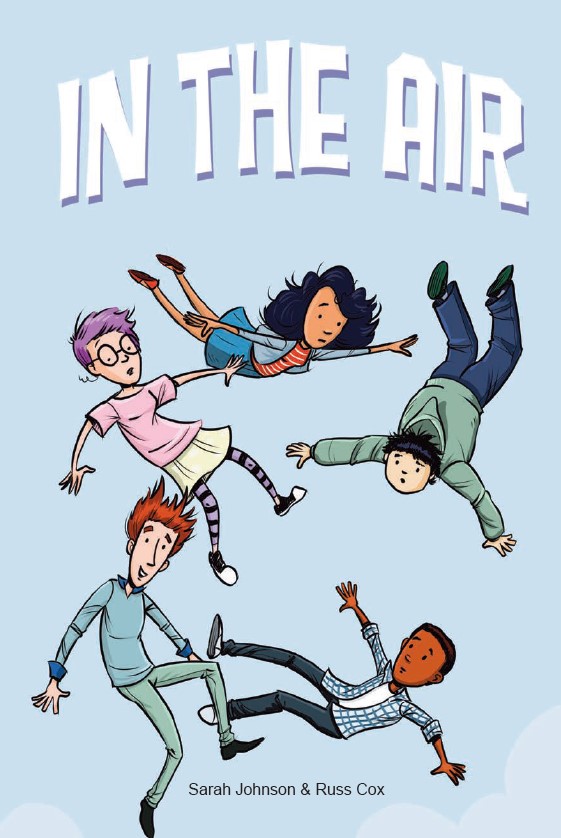
In the Air by Sarah Johnson & Russ Cox-
A graphic medicine built to foster conversations with and among young people around vaping, choices about substance use, and social factors. This graphic novel-styled story of five teens going through high school incorporates behavioral science of substance misuse prevention with the stories, interest, and ideas of members of the Tobacco Free Rhode Island Youth Ambassadors. The novel has questions to help guide the discussion, a strong research base, and roots in risk and protective factors.
We can provide free hard copies of In The Air. email brian@healthylamoillevalley.org if you are interested
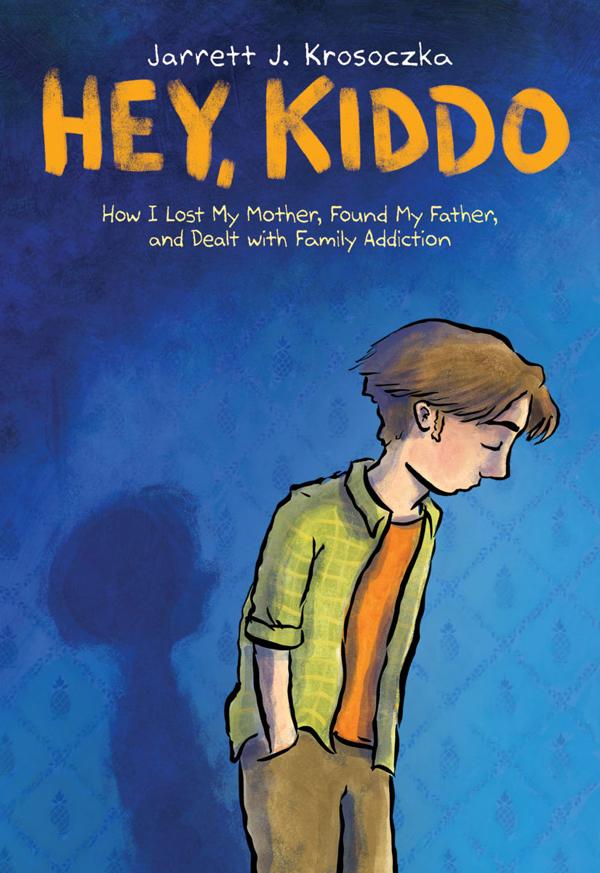
Hey, Kiddo by Jarrett J. Krosoczka
Hey, Kiddo is a profoundly important memoir about growing up in a family grappling with addiction, and finding the art that helps you survive.
8 Young Adult Reads to Spark Authentic Discussions About Drugs & Alcohol
The following titles are young adult books that middle and high school teachers can use as a basis for strong, authentic classroom conversations about drugs and alcohol. These are stories about realistic, complex characters who are facing risks, tough decisions and the influence of their peers—stories that will spark discussions about the development and vulnerability of the teen brain and subsequent risk-taking behavior, the influence an environment can have on the choices a person makes, and more. Don’t have room in your curriculum for new books? Try choosing one to read with your advisory group or home room or with an after-school reading group.
Common Sense Media – Books for Kids and Teens About Alcohol and Drug Abuse
Kids who live with — or have been separated from — alcoholic or drug-addicted adults have lots to deal with in addition to all the other hard stuff that comes with growing up. Feelings of loss, grief, anger, isolation, and shame crowd in on school experiences, relationships, and even their sense of self. Reading about characters who are dealing with loved ones’ abuse of alcohol, opioids, or other substances — or about teens who are struggling with addiction — can help kids deal with complex family dynamics and keep hope alive
20 Books to Explain Addiction to Children
When a child grows up in a home where a parent or other loved one has a substance use disorder, they often feel confused and frightened. Their home life may be chaotic and unpredictable. They may hear arguing, crying, or yelling and have no understanding of why it is happening. Some children draw the conclusion that they are the cause of the problems. Others become withdrawn, act out, or become aggressive. These 20 children’s books about addiction can help parents explain substance use disorders in an age-appropriate way.
Opportunities for Students
Create a Substance Prevention Committee at your school or in your school district that includes a diverse group of students. Making sure any endeavors your school undertakes is youth-driven and/or youth-informed.
GETTING TO ‘Y’- is an opportunity for students to bring meaning to their own Youth Risk Behavior Survey data. Through youth leadership, partnerships with adults, participatory action research, and peer and community engagement, participants not only experience personal growth and build their capacity for future civic engagement, but also effect sustainable change in youth behavior, community and school culture.
Our Voices Xposed / Vermont Kids Against Tobacco (OVX/VKAT) – The OVX (high school) and VKAT (middle school) groups engage and empower youth ages 10 to 18. Through youth leadership opportunities, they educate students, community members, and decision makers on the tactics used by the tobacco industry, encourage healthy choices among peers, and work to reduce tobacco use and change social norms. OVX and VKAT also work with the Vermont Department of Health on media and counter-tobacco marketing campaigns. Contact Brian – brian@healthylamoillevalley.org – if you are interest in starting a group at your school.
Lamoille Area Youth Coalition – An opportunity for 6th-12th grade students in the Lamoille Valley region (all of Lamoille County, plus the Greater Hardwick Area (Hardwick, Craftsbury, Greensboro, Stannard, and Woodbury) to engage in projects aimed at reducing youth substance misuse and promoting healthy choices. Email youth@healthylamoillevalley.org for more info or check out their website here!
Lamoille North Youth Coalition – A chapter of LAYC that is co-facilitated by Brian (Youth Coordinator) and Amy (LUMS health teacher) and meets Wednesdays after school. It is primarily a middle school (7th/8th) group, but we invite high school students to learn more if they are interested in being a youth coalition leader. Email Brian at brian@healthylamoillevalley.org for more information.
Substance Refusal Skills Workshop for Middle Schoolers (Ideal for 5th/6th graders) Middle schoolers are in a pivotal transition and are beginning to enter a phase in their lives where they may be offered substances. In this workshop, students will learn the statistics related to local youth substance misuse, identify motivations for substance use and alternative choices, reflect on reasons to be substance-free, and practice refusal skills for scenarios where they may be offered substances. This workshop can be delivered by Brian, Healthy Lamoille Valley’s Youth Substance Prevention Coordinator, or can be implemented by an school educator. Contact Brian (brian@healthylamoillevalley.org) for more details.
Other Opportunities – The Healthy Lamoille Valley team is happy to brainstorm other ways to include prevention in third space student interactions such as afterschool clubs, theater, music, arts, sports, etc.
Substance Prevention Action Plan Template for Schools and Educators
Click here for PDF Action Plan Template
Click here for Google Doc Action Plan Template
Aim to make your action plan:
Youth-informed and/or youth-driven
Collaborative with the school community and community at large
Equitable – Inclusive of all populations
Evidence-based
Integrated into a whole school approach
Sustainable
